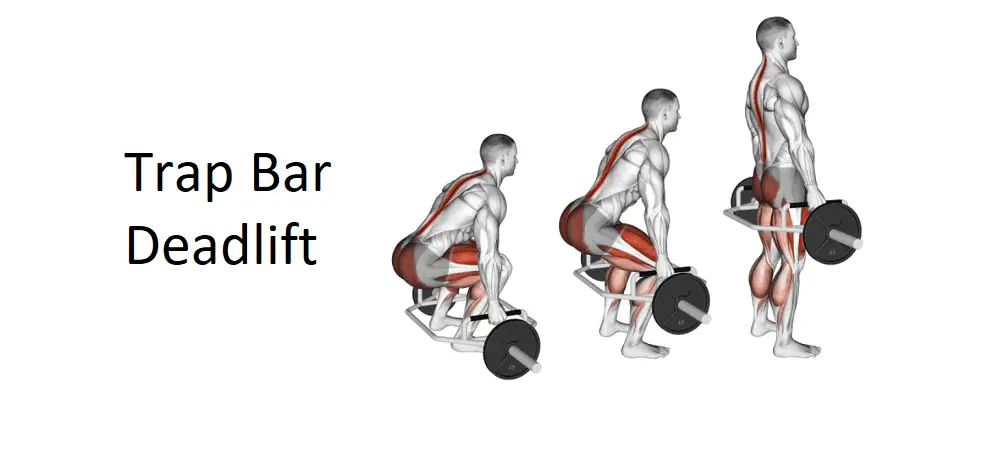Table of Contents
Introduction of Trap Bar Deadlift
The Trap Bar Deadlift, also known as the Hex Bar Deadlift, is a compound exercise that targets multiple muscle groups, including the glutes, hamstrings, quadriceps, lower back, and traps. This variation of the traditional deadlift is performed using a trap bar, which allows for a more upright torso position and places less stress on the lower back. In this comprehensive guide, we’ll explore the correct technique, benefits, variations, and other essential details associated with the Trap Bar Deadlift.
Instructions for Trap Bar Deadlift
Setup:
- Foot Placement: Stand inside the trap bar with your feet shoulder-width apart or slightly wider. The mid-foot should be aligned with the center of the handles.
- Grip: Grasp the handles of the trap bar with a neutral grip (palms facing each other) or an overhand grip (palms facing toward you). Ensure a firm grip on the handles.
- Hip Position: Bend at the hips and knees to lower your body down to the handles of the trap bar. Keep your chest up, back flat, and shoulders pulled back.
Execution:
- Lift: With a tight core and engaged back muscles, drive through your heels and extend your hips and knees simultaneously to lift the trap bar off the ground. Keep the bar close to your body throughout the movement.
- Extension: Once standing upright, fully extend your hips and knees while maintaining a neutral spine. Squeeze your glutes at the top of the movement to maximize hip extension.
- Lowering: To lower the trap bar back to the ground, hinge at the hips and bend your knees, keeping the bar close to your body. Lower the weight under control, maintaining proper form.
- Repeat: Perform the desired number of repetitions with smooth and controlled movements, focusing on maintaining proper technique throughout the exercise.
Benefits
- Full Body Strength: The Trap Bar Deadlift targets multiple muscle groups, including the glutes, hamstrings, quadriceps, lower back, and traps, making it an excellent exercise for building overall strength and muscle mass.
- Reduced Lower Back Stress: The trap bar design allows for a more upright torso position compared to the conventional deadlift, which reduces stress on the lower back. This makes it a safer option for individuals with lower back issues or limitations.
- Functional Movement: The Trap Bar Deadlift mimics natural movement patterns such as lifting objects from the ground, making it a functional exercise that translates to real-life activities and sports performance.
- Increased Grip Strength: Holding onto the handles of the trap bar challenges grip strength and forearm muscles, leading to improvements in grip strength and overall grip endurance.
Muscles worked in Trap Bar Deadlift
The Trap Bar Deadlift primarily targets the following muscle groups:
- Glutes: The gluteus maximus, medius, and minimus are heavily engaged during the Trap Bar Deadlift. These muscles are responsible for hip extension, which is essential for lifting the weight from the ground.
- Hamstrings: The hamstrings, including the biceps femoris, semitendinosus, and semimembranosus, act as hip extensors and knee flexors during the movement. They work in conjunction with the glutes to lift the weight and stabilize the knees.
- Quadriceps: The quadriceps muscles, including the rectus femoris, vastus lateralis, vastus medialis, and vastus intermedius, are activated to extend the knees and drive the body upward from the squatting position.
- Erector Spinae: The erector spinae muscles, located along the spine, work to stabilize the torso and maintain a neutral spine position throughout the movement. They help prevent rounding or excessive arching of the lower back.
- Trapezius: The trapezius muscles, particularly the upper traps, are engaged to stabilize the shoulders and upper back during the lifting phase. They help maintain proper posture and shoulder alignment.
- Forearms and Grip: The muscles of the forearms, including the flexors and extensors, are activated to maintain a secure grip on the trap bar handles. Grip strength is essential for holding onto the weight throughout the exercise.
- Core: The muscles of the core, including the rectus abdominis, obliques, and transverse abdominis, work to stabilize the spine and pelvis during the movement. A strong core is essential for maintaining proper form and transferring force between the lower and upper body.
By targeting these muscle groups, the Trap Bar Deadlift provides a comprehensive lower body and posterior chain workout, promoting strength, stability, and muscular development throughout the body.
Alternate names for Trap Bar Deadlift
- Hex Bar Deadlift
- Trap Bar Lift
- Hexagonal Bar Deadlift
- Diamond Bar Deadlift
FAQs
What is a Trap Bar Deadlift?
The Trap Bar Deadlift, also known as the Hex Bar Deadlift, is a variation of the traditional deadlift exercise. It involves lifting a loaded barbell from the ground using a hexagonal-shaped barbell known as a trap bar, which allows for a more neutral grip and typically places less stress on the lower back compared to a straight barbell deadlift.
How do you perform a Trap Bar Deadlift?
Begin by standing inside the trap bar with your feet hip-width apart and your toes pointing slightly outward. Grip the handles of the trap bar with your palms facing each other or slightly inward.
Engage your core, keep your chest up, and maintain a flat back as you hinge at the hips and bend your knees to lower your torso and grip the handles.
Drive through your heels and push your hips forward as you stand up, lifting the trap bar off the ground. Keep the bar close to your body throughout the movement.
Fully extend your hips and knees at the top of the lift, then lower the trap bar back down to the ground under control.
Repeat for the desired number of repetitions.
Which muscles does the Trap Bar Deadlift target?
The Trap Bar Deadlift primarily targets the posterior chain muscles, including the glutes, hamstrings, and lower back. Additionally, it engages the quadriceps, calves, and grip muscles to varying degrees.
What equipment is needed for the Trap Bar Deadlift?
You’ll need access to a trap bar, which is a specialized barbell with a hexagonal shape that allows for a more neutral grip. Additionally, you’ll need weight plates to load the trap bar to your desired resistance level.
What are the benefits of the Trap Bar Deadlift?
The Trap Bar Deadlift offers several benefits, including:Reduced stress on the lower back:
The trap bar’s design allows for a more upright torso position compared to a straight barbell deadlift, which may reduce strain on the lower back.
Increased quadriceps involvement: The more vertical torso angle in the trap bar deadlift compared to the conventional deadlift can lead to greater quadriceps activation.
Improved grip strength: Holding the handles of the trap bar challenges grip strength, making it a beneficial exercise for grip development.
Is the Trap Bar Deadlift suitable for beginners?
Yes, the Trap Bar Deadlift can be suitable for beginners, especially those who may have mobility or flexibility limitations that make traditional deadlifts challenging. The trap bar’s design allows for a more natural movement pattern and may be easier to learn for beginners.
How many sets and reps should I do for the Trap Bar Deadlift?
The number of sets and reps can vary depending on your fitness goals, experience level, and overall workout routine. A typical range might be 3-4 sets of 5-8 repetitions for strength development, or higher rep ranges for muscle hypertrophy.
Are there any safety considerations for the Trap Bar Deadlift?
While the Trap Bar Deadlift is generally considered a safe exercise, it’s essential to use proper form and technique to minimize the risk of injury. Ensure that your back remains flat, your core is engaged, and you lift the weight with control. Additionally, start with lighter weights and gradually increase the load as you become more comfortable with the exercise.
Can the Trap Bar Deadlift help with building muscle and strength?
Yes, the Trap Bar Deadlift is an effective exercise for building muscle and strength in the posterior chain muscles, including the glutes, hamstrings, and lower back. By progressively overloading the muscles with heavier weights and proper technique, you can stimulate muscle growth and strength gains over time.
Should I feel any discomfort during the Trap Bar Deadlift?
You may experience muscle fatigue or discomfort in the muscles being worked, particularly the glutes, hamstrings, and lower back. However, you should not feel sharp or shooting pain, especially in the lower back. If you do, stop the exercise immediately and reassess your form or seek guidance from a fitness professional.
Variations
- Sumo Stance Trap Bar Deadlift: Perform the Trap Bar Deadlift with a wider stance, toes pointed outward, and hands placed inside the handles. This variation emphasizes the inner thigh muscles and reduces stress on the lower back.
- Single-Leg Trap Bar Deadlift: Perform the exercise using one leg at a time to improve balance, stability, and unilateral lower body strength.
- Deficit Trap Bar Deadlift: Stand on a raised platform or weight plates to increase the range of motion and further challenge the muscles involved in the deadlift.
Conclusion
Incorporating the Trap Bar Deadlift into your strength training routine can offer a variety of benefits, including increased muscle strength, improved lower body development, reduced lower back stress, and enhanced functional movement patterns. By mastering the proper technique and gradually increasing the load over time, you can maximize the effectiveness of this compound exercise and achieve your strength and fitness goals.
Video of Trap Bar Deadlift
Other Thigh Exercises
Please check our home page for the latest posts.
Other reading: Trap Bar Deadlifts are Underrated








